Calendar
Protomartyr and Archdeacon Stephen
8. January 2016 - 23:10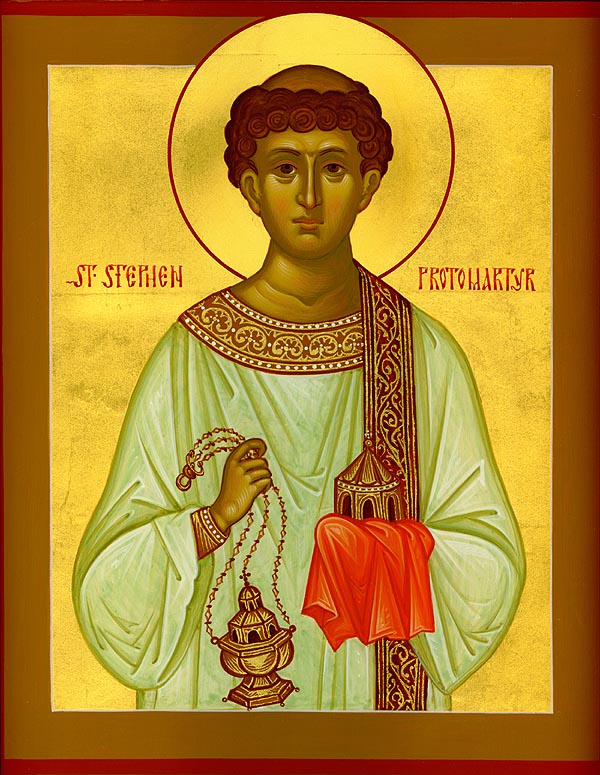 The Holy Protomartyr and Archdeacon Stephen was the eldest of the seven deacons, appointed by the Apostles themselves, and therefore he is called “archdeacon.” He was the first Christian martyr, and he suffered for Christ when he was about thirty. In the words of Asterias, he was “the starting point of the martyrs, the instructor of suffering for Christ, the foundation of righteous confession, since Stephen was the first to shed his blood for the Gospel.”
The Holy Protomartyr and Archdeacon Stephen was the eldest of the seven deacons, appointed by the Apostles themselves, and therefore he is called “archdeacon.” He was the first Christian martyr, and he suffered for Christ when he was about thirty. In the words of Asterias, he was “the starting point of the martyrs, the instructor of suffering for Christ, the foundation of righteous confession, since Stephen was the first to shed his blood for the Gospel.”
Filled with the Holy Spirit, St Stephen preached Christianity and defeated Jewish teachers of the Law in debate. The Jews maligned St Stephen, saying that he had uttered blasphemy against God and against Moses. St Stephen came before the Sanhedrin and the High Priest to answer these charges. He gave a fiery speech, in which he recounted the history of the Jewish nation, and denounced the Jews for persecuting the prophets, and also for executing the promised Messiah, Jesus Christ (Acts ch. 7).
The Hieromartyr Ignatius the God-bearer
2. January 2016 - 12:43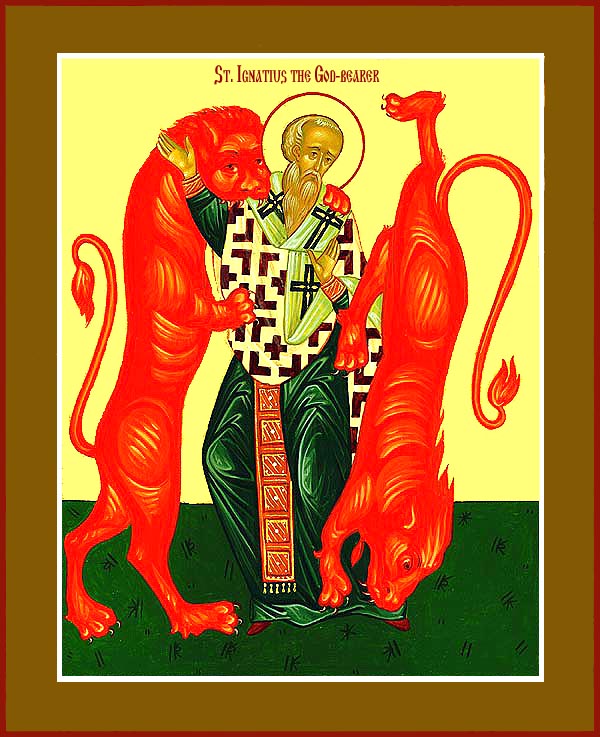 This holy man is called ``the God-bearer'' because he constantly bore the name of the Living God in his heart and on his lips. According to tradition, he was thus named because he was held in the arms of God Incarnate, Jesus Christ. On a day when the Lord was teaching His disciples humility, He took a child and placed him among them, saying: Whosoever therefore shall humble himself as this little child, the same is greatest in the Kingdom of Heaven (Matthew 18:4). This child was Ignatius. Later, Ignatius was a disciple of St. John the Theologian, together with Polycarp, Bishop of Smyrna. As Bishop of Antioch, Ignatius governed the Church of God as a good shepherd and was the first to introduce antiphonal chanting in the Church, in which two choirs alternate the chanting. This manner of chanting was revealed to St. Ignatius by the angels in heaven. When Emperor Trajan was passing through Antioch on his way to do battle with the Persians, he heard of Ignatius, summoned him and counseled him to offer sacrifice to the idols. If Ignatius would do so, Trajan would bestow upon him the rank of senator. As the counsels and threats of the emperor were in vain, St. Ignatius was shackled in irons and sent to Rome in the company of ten merciless soldiers, to be thrown to the wild beasts. Ignatius rejoiced in suffering for his Lord, only praying to God that the wild beasts would become the tomb for his body and that no one would prevent him from this death. After a long and difficult journey from Asia through Thrace, Macedonia and Epirus, Ignatius arrived in Rome, where he was thrown to the lions in the circus. The lions tore him to pieces and devoured him, leaving only several of the larger bones and his heart. This glorious lover of the Lord Christ suffered in the year 106 in Rome at the time of the Christ-hating Emperor Trajan. Ignatius has appeared many times from the other world and worked miracles, even to this day helping all who call upon him for help.
This holy man is called ``the God-bearer'' because he constantly bore the name of the Living God in his heart and on his lips. According to tradition, he was thus named because he was held in the arms of God Incarnate, Jesus Christ. On a day when the Lord was teaching His disciples humility, He took a child and placed him among them, saying: Whosoever therefore shall humble himself as this little child, the same is greatest in the Kingdom of Heaven (Matthew 18:4). This child was Ignatius. Later, Ignatius was a disciple of St. John the Theologian, together with Polycarp, Bishop of Smyrna. As Bishop of Antioch, Ignatius governed the Church of God as a good shepherd and was the first to introduce antiphonal chanting in the Church, in which two choirs alternate the chanting. This manner of chanting was revealed to St. Ignatius by the angels in heaven. When Emperor Trajan was passing through Antioch on his way to do battle with the Persians, he heard of Ignatius, summoned him and counseled him to offer sacrifice to the idols. If Ignatius would do so, Trajan would bestow upon him the rank of senator. As the counsels and threats of the emperor were in vain, St. Ignatius was shackled in irons and sent to Rome in the company of ten merciless soldiers, to be thrown to the wild beasts. Ignatius rejoiced in suffering for his Lord, only praying to God that the wild beasts would become the tomb for his body and that no one would prevent him from this death. After a long and difficult journey from Asia through Thrace, Macedonia and Epirus, Ignatius arrived in Rome, where he was thrown to the lions in the circus. The lions tore him to pieces and devoured him, leaving only several of the larger bones and his heart. This glorious lover of the Lord Christ suffered in the year 106 in Rome at the time of the Christ-hating Emperor Trajan. Ignatius has appeared many times from the other world and worked miracles, even to this day helping all who call upon him for help.
Saint Danilo, Archbishop of Serbia
2. January 2016 - 11:51 Danilo was the son of wealthy and God-loving parents. In his youth he was given a good upbringing. King Milutin took him to his court, but out of great love for God he fled and was tonsured a monk in the Monastery of Konèulsk near the Ibar. Later, he was the abbot of the Monastery of Hilandar [Mount Athos] and suffered much from the plundering Latin Crusaders. He was the Bishop of Banja, then of Hum, and finally the Archbishop of Serbia. From beginning to end, he was a strict ascetic and had the special gift of tears. He made peace between Kings Dragutin and Milutin, and later between Milutin and Stefan of Deèani. He fought fervently against the Latins as well as the Bogomils. Under his supervision, the Monasteries of Banja and Deèani were built, and he restored and built many other churches. He wrote the genealogy of the Serbian kings and saints. Untiring in his service to God to the end of his life, he entered peacefully into rest on the night between the nineteenth and twentieth of December, 1338, during the reign of Tsar Du an. Danilo was a great hierarch, a great ascetic, a great laborer and a great patriot.
Danilo was the son of wealthy and God-loving parents. In his youth he was given a good upbringing. King Milutin took him to his court, but out of great love for God he fled and was tonsured a monk in the Monastery of Konèulsk near the Ibar. Later, he was the abbot of the Monastery of Hilandar [Mount Athos] and suffered much from the plundering Latin Crusaders. He was the Bishop of Banja, then of Hum, and finally the Archbishop of Serbia. From beginning to end, he was a strict ascetic and had the special gift of tears. He made peace between Kings Dragutin and Milutin, and later between Milutin and Stefan of Deèani. He fought fervently against the Latins as well as the Bogomils. Under his supervision, the Monasteries of Banja and Deèani were built, and he restored and built many other churches. He wrote the genealogy of the Serbian kings and saints. Untiring in his service to God to the end of his life, he entered peacefully into rest on the night between the nineteenth and twentieth of December, 1338, during the reign of Tsar Du an. Danilo was a great hierarch, a great ascetic, a great laborer and a great patriot.
The Commemoration of the Great Earthquake at Constantinople and St. Demetrius
8. November 2015 - 12:43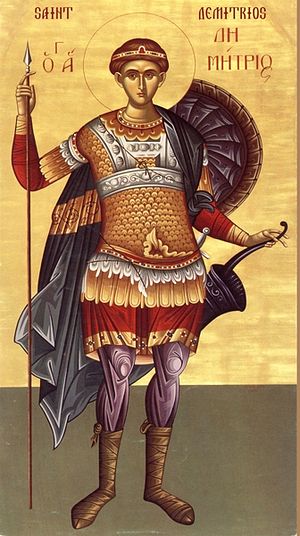 One may well wonder why we are commemorating this particular earthquake. After all, there have been many earthquakes, as well as other natural disasters in human history – so why commemorate this one?
One may well wonder why we are commemorating this particular earthquake. After all, there have been many earthquakes, as well as other natural disasters in human history – so why commemorate this one?
This earthquake in Constantinople took place in 740 AD. This was at the time Emperor Leo was destroying icons and the people of Constantinople felt that it was God’s anger that led to this disaster. The believers prayed to St. Demetrius of Thessalonica and the earthquakes ceased.
St. Demetrius of Thessalonica is a third to 4th century martyr. He was born in 270 AD in Thessalonica. He came from a noble Roman background and according to some traditions he was a soldier, and is depicted as a solder on his icons. He was martyred in approximately 306 AD during the persecution of the Roman Emperors Diocletian and Galerias. During the reign of the Emperor St. Constantine (306-337) his relics were exhumed and it was found that the relics streamed myrrh, a miraculous sign which pointed to St. Demetrius being a saint, and a church was built for these remains in Thessalonica and they remain there today. Emperors sometimes tried to bring the relics to Constantinople, but the saint always revealed that his relics should stay where they were. For centuries, the people of Thessalonica prayed to St. Demetrius to save them from natural disasters and enemy attack.
Feast of Nativity of our Most Holy Lady, the Theotokos, and Ever-Virgin Mary
20. September 2015 - 21:09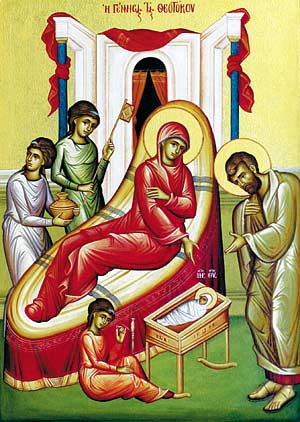 The Feast of the Nativity of Our Most Holy Lady, the Theotokos and Ever-Virgin Mary is celebrated on September 8 each year. The Feast commemorates the birth of the Mother of Jesus Christ, our Lord.
The Feast of the Nativity of Our Most Holy Lady, the Theotokos and Ever-Virgin Mary is celebrated on September 8 each year. The Feast commemorates the birth of the Mother of Jesus Christ, our Lord.
BACKGROUND
The birth and early life of the Virgin Mary is not recorded in the Gospels or other books of the New Testament, however this information can be found in a work dating from the second century known as the Book of James or Protevangelion.
According to the story found in this book, Mary's parents, Joachim and Anna, were childless for many years. They remained faithful to God, but their prayers for a child were unanswered. One day, when Joachim came to the temple to make an offering, he was turned away by the High Priest who chastised him for his lack of children. To hide his shame, Joachim retreated to the hill country to live among the shepherds and their flocks.
The Dormition of our Most Holy Lady the Mother of God and Ever-Virgin Mary
27. August 2015 - 12:03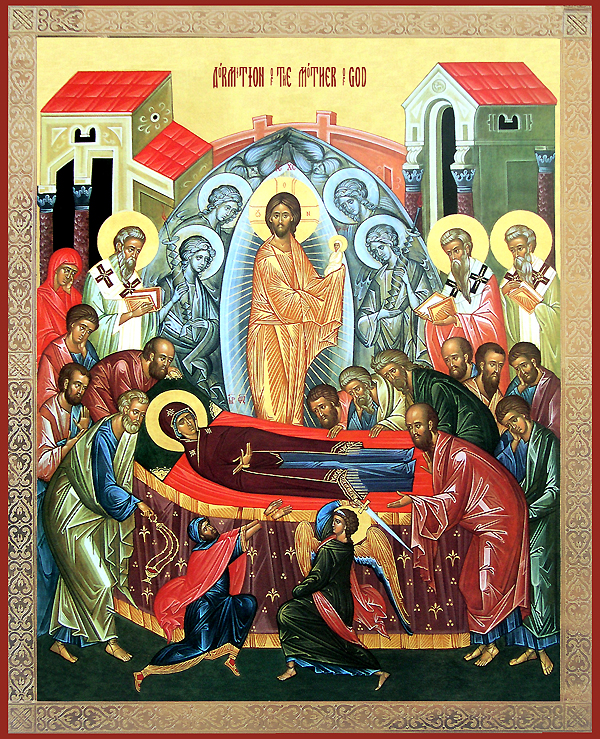 The Dormition of our Most Holy Lady Theotokos and Ever-Virgin Mary: After the Ascension of the Lord, the Mother of God remained in the care of the Apostle John the Theologian, and during his journeys She lived at the home of his parents, near the Mount of Olives. She was a source of consolation and edification both for the Apostles and for all the believers. Conversing with them, She told them about miraculous events: the Annunciation, the seedless and undefiled Conception of Christ born of Her, about His early childhood, and about His earthly life. Like the Apostles, She helped plant and strengthen the Christian Church by Her presence, Her discourse and Her prayers.
The Dormition of our Most Holy Lady Theotokos and Ever-Virgin Mary: After the Ascension of the Lord, the Mother of God remained in the care of the Apostle John the Theologian, and during his journeys She lived at the home of his parents, near the Mount of Olives. She was a source of consolation and edification both for the Apostles and for all the believers. Conversing with them, She told them about miraculous events: the Annunciation, the seedless and undefiled Conception of Christ born of Her, about His early childhood, and about His earthly life. Like the Apostles, She helped plant and strengthen the Christian Church by Her presence, Her discourse and Her prayers.
The reverence of the Apostles for the Most Holy Virgin was extraordinary. After the receiving of the Holy Spirit on the day of Pentecost, the Apostles remained at Jerusalem for about ten years attending to the salvation of the Jews, and wanting moreover to see the Mother of God and hear Her holy discourse. Many of the newly-enlightened in the Faith even came from faraway lands to Jerusalem, to see and to hear the All-Pure Mother of God.

